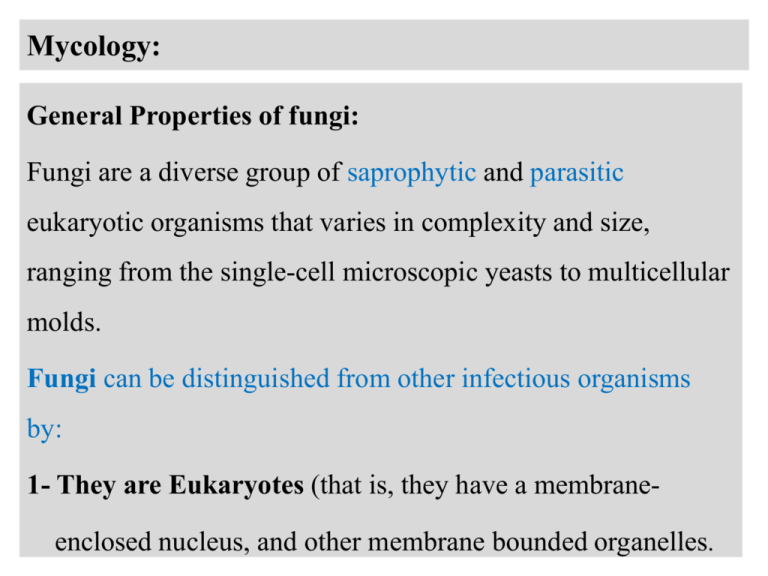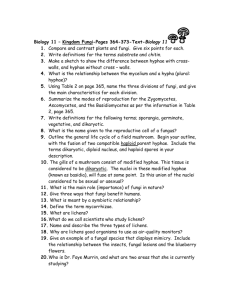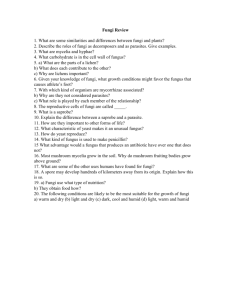11-12Introduction to Mycology_modified_05
advertisement

Mycology: General Properties of fungi: Fungi are a diverse group of saprophytic and parasitic eukaryotic organisms that varies in complexity and size, ranging from the single-cell microscopic yeasts to multicellular molds. Fungi can be distinguished from other infectious organisms by: 1- They are Eukaryotes (that is, they have a membraneenclosed nucleus, and other membrane bounded organelles. n 2- Cell wall and membrane components: Fungal cell wall are composed largely of Chitin, a polymer of N-acetylglucosamine, rather than peptidoglycan. The fungal membrane contains ergosterol, rather than the Cholesterol found in mammalian membranes. a 3- All fungi are Heterotrophes ,and Chemotrophic organisms. Fungi secrete degradative enzymes ( cellulases, proteases, nucleases) into their immediate environment. 4- Fungi are Facultative anaerobic or obligatory aerobic organisms. 5-Most fungi are Acidophilic organisms. 6- Fungi reproduce and spread through the environment by Spore formation which may be sexual or asexual. Fungi Morphology: Fungi exist into two main forms yeasts or hyphae (Moulds). Some fungi may occur in both the yeast and mycelial forms. These are called dimorphic fungi. Hyphae are multicellular filamentous structures, constituted by tubular cells with cell walls. a Yeasts are Unicellular non-branched, oval or rounded cells, measuring 3- 15 µm in diameter. Yeasts reproduce asexually by budding (blastospore, and chlamydospores). Dimorphic fungi These fungi are changing their morphology from mould to yeast phase, or from yeast to mould depending on the growth conditions. 1. Yeast : (parasitic or pathogenic form): This is the form usually seen in tissue, in exudates, or if cultured in an incubator at 37ºC. 2. Mycelium :( saprophytic or mold form): The form observed in nature or when cultured at 25ºC. Characteristics of Fungal Hyphae: Septate versus Coenocytic Fungal Diseases: Fungal diseases can be classified into the following groups: 1-Hypersensitivity (allergy): It is an allergic reaction to molds and spores ( Indoor air pollution). 2-Mycotoxicoses: Poisoning of man and animals due to accidental ingestion of food contaminated by toxic compounds produced by fungi. Examples: A- Ergotism: caused by Claviceps purpurea ; (Ergot alkaloids) . B- Aflatoxicosis: caused by Aspergillus flavus (Aflatoxins). n 3-Mycetismus: Due to ingestion of Amanitins (a toxin produced by a specific type of mushroom ; Amanita verna ). 4-Infection (Mycosis): A-Superficial (Hair, skin, nail, cornea) mycosis. B-Subcutaneous mycosis. C-True systemic (endemic) mycosis. D-Opportunistic mycosis. SUPERFICIAL MYCOSIS: The superficial mycoses are usually limited to the outermost layers of the skin, hair, and nails, and do not invade living tissues. Most common Types: 1- Dermatophytosis. 2- Pityriasis versicolor. Dermatophytosis: (Tinea or Ringworm): It is a type of superficial skin infection of cutaneous layer (mainly epidermis). Causes: *Epidermophyton (Skin and nail) *Microsporum ( Skin and hair) *Trichophyton ( Hair.Skin & nail) a Pityriasis Versicolor: It is a superficial chronic infection of stratum corneum. This fungal infection is caused by: Malassezia furfur. (a lipophilic yeast organism). Other superficial infection of skin: 1-Tinea Nigra: Exophiala werneckii : Infection of Stratum corneum (Outermost layer of epidermis) 2-Black Piedra: Piedraia hortae Infections of scalp hair. 3-White Piedra Trichosporon beigelii : Fungal infection of facial, axillary or genital hair. Types of superficial Mycosis: a Subcutaneous Mycosis: Sporotrichosis: Caused by Sporothrix schenkii. At 25°C: Septate hyphae, rosette-like clusters of conidia at the tips of the hyphae. At 35 C: yeast. Systemic Mycosis: Respiratory system infection: Chronic granulomatous pneumonia. Causes: Histoplasma capsulatum (dimorphic fungi). Coccidioides immitis (dimorphic fungi). Opportunistic mycosis: Candidiasis: Candida albicans infection. Example: 1-Oral Candidiasis. 2-Vaginal Candidiasis. Laboratory Diagnosis of Fungal Infections: (1) Specimens: According to the site of infection as, skin scales, hairs, nails, respiratory secretions, blood, … (2) Direct Detection: A- Direct microscopy of unstained preparations (mounting method): Examination of unstained preparations to demonstrate hyphae, spores or yeast cells. Skin scraping, nails or hairs are mounted with 10-20% KOH to digest the keratin layer so that hyphae and spores can be seen. B- Direct microscopy of stained preparations: Different stains are used, e.g. India ink, Periodic Acid Schiff (PAS), silver stain and Lactophenol cotton blue stain (specific fungal stain). n (3) Culture: Sabouraud`s dextrose agar (SDA): the standard media for most fungi. Chloramphenicol added to inhibit bacterial growth & cycloheximide added to inhibit saprophytic fungi. Incubation temperature is 22°C. If systemic mycosis is suspected, Enriched media is used and incubated at 37°C. (4) Serodiagnosis: Detection of specific antibody help in diagnosis of systemic mycosis. (4) Cutaneous delayed type hypersensitivity test: Example: histoplasmin skin test and blastomycin skin test. For identification of systemic mycosis. Dermatophyte morphology: a







